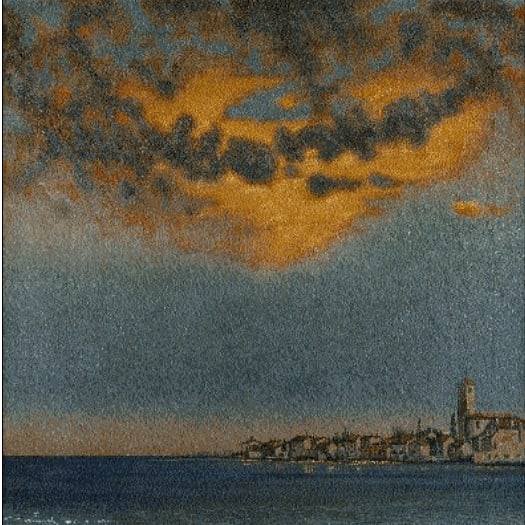
Vito TIMMEL
Nocturne on the Sea, 1941
Mixed technique on black cardboard
Signed and dated lower right: Timmel / XXXI VIII XXXXI
Vito TIMMEL
(Vienna 1886 – Trieste 1949)
“His decorative sense, with his always unexpected, occasionally exquisite, colour innovations, achieves the grace of an arabesque.”
- Silvio Benco[1]
An elegant exponent of the Viennese Secession, a whimsical and highly capricious artist, Vito Timmel painted portraits and post-impressionist landscapes with intense colours and lighting of a great optical effect, alternating between naïve and Secessionist styles.
Timmel was an artist who was highly regarded by the critics of the time. The originality of his mark, his Nordic accent, and the expressive strength of his style were assuredly linked to his Viennese education, his frequentation of Secessionist circles, his fellow students at the Academy of Fine Arts in Vienna who included Gerstl, Kokoschka and Schiele, and above all his much-admired teacher, Gustav Klimt. Like Klimt, Timmel demonstrated an ability to fuse different heterogeneous and apparently contradictory suggestions, ranging from Byzantine art to Japanese art and oriental decorative art in general, without foregoing a compositional rigour of a classical derivation, accompanied by literary, mythological and musical influences.
The work presented here, Nocturne on the Sea, dated 1941, is part of a group of paintings in which the artist magically dissolved the landscape, deciphering it through a play on different densities of colour and luminescent dots. Here, a nocturnal moonlit seascape is described with an almost mathematical attention and precision in the execution of each single reflection of the lights on the sea. We find some elements that are also present in other works from this period, almost as if the artist were building his own mark and iconographic language: the stylized sliver of moon (also present in the work Chiaro di Luna, 1939 – Fig. 1), the billowing clouds with their cartoon-like features (see the work Isola d’Istria, 1941 – Fig. 2).
The result is a sort of fairytale atmosphere rendered through the technique of dots and small areas of dashes.
“A great simplifying and, above all, stylizing imagination. Style of line, form, colour, and the whole likewise. A summary of concept. A summary of conquest; illustrative, decorative, ornamental, a summary of impression and expression.”[2]
- Giuseppe Matteo Campitelli

Fig. 1
Chiaro di luna, 1939

Fig. 2
Isola d'Istria, 1941